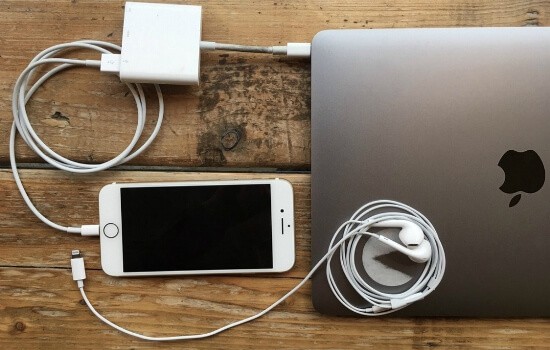What Reason IPhone 7 Headphones Don’t Work On The Latest MacBook
What Reason IPhone 7 Headphones Don’t Work On The Latest MacBook : Recently, a new staff member started at FoodFactFun. She booted up her brand-new, company-issued MacBook Pro, and went to plug in her EarPods to listen to some tunes while she worked. She was met with the same baffling conundrum as other Apple die-hards who rush to procure the latest release: Why the hell can’t you use the iPhone 7’s Lightning connector headphones with the new MacBook Pro?
Why Get Lightning Headphones in the First Place?
First, some background. In 2012, Apple introduced the smaller Lightning port on the iPhone 5 replacing the 30-pin port of previous models . While the Lightning port necessitated a new charging cable, the Lightning connector was more compact than its predecessor and one could plug it into iOS devices in either direction, making it more convenient. With the iPhone 7, Apple made the “courageous” decision to force the use of its Lightning-compatible EarPod headphones by removing the 3.5mm headphone jack from the phone altogether.
In short, your 3.5mm headphones and their traditional headphone jack were out. Either you used the EarPods that came with the phone, you bought a new pair of Lightning headphones, or you went wireless with Bluetooth-compatible headphones to listen to music. What Reason IPhone 7 Headphones Don’t Work On The Latest MacBook
Why Get Lightning Headphones in the First Place?
Using your old 3.5mm headphones with your iPhone 7 is still possible. But requires the 3.5mm-to-Lightning adapter that comes included with the new iPhone. That meant carrying around an extra, easy-to-lose little piece of equipment. It’s an example of Apple making design decisions that impact function for the sake of form. A decision the company’s made at many points in its past (for example, its decision to remove the optical drive in its 2012 iMacs ).
Removing the 3.5mm headphone jack was was a positive change, by some metrics. By routing audio through the Lightning port, the phone can play higher quality, 24-bit audio files. Also known as “high-res audio,” which permits you to listen to studio-quality music. Headphone manufacturers are also taking advantage of the fact that headphones can draw power from the iPhone’s Lightning port. Adding features like noise cancellation and interference-reducing DACs ( digital-to-analog converters ) to improve sound quality.
But Lightning-only headphones only work on iOS devices with Lightning ports. To listen to music on anything else, like your computer, or even an older iPhone, you’ll need to tote around another pair of headphones. What Reason IPhone 7 Headphones Don’t Work On The Latest MacBook
There Are No Functional Adapters Yet
Naturally, you might think there’s some sort of workaround , or an adapter that can easily fix this incompatibility issue. After all, Apple makes its own adapters for a variety of older interfaces (for instance, VGA port adapters for mirroring your iOS device on a monitor).
But unlike 3.5mm headphones, which can be used with an iPhone 7 via the Apple-made dongle, there’s no way to do the reverse and get Lightning headphones to work with anything that doesn’t have a Lightning port, making my colleague’s new MacBook Pro, with its four high-speed, reversible USB-C ports and single 3.5mm headphone jack incompatible with her headphones.
A dongle does exist to plug Lightning port headphones into a USB-C port, and we tried one, but it still didn’t fix the problem. Lightning-to-USB-C adapters only work when charging or transferring data. Which means no audio support, which means no EarPod-powered desk concerts in your open-plan office.
Apple Is Comfortable With User-Hostile Tech
Apple’s Lightning connector is convenient for Apple, but not so much for the rest of us. It’s only available on Apple’s iOS devices, making switching to, say, an Android device an inconvenient. Pricey decision-you’ll need new cables, headphones, docks etc. To play nice with others, Apple should have either left the 3.5mm headphone jack alone on the iPhone,. Switched to USB-C, which is what every other cell phone manufacturer is doing.
And while their move towards incompatibility with other company’s devices isn’t surprising, it does seem a little weird that they’d build this kind of glaring incompatibility into their two most recent devices-the iPhone 7 and the latest MacBook pro.
The decision to exclude the Lightning port from its Macs-and not to publicly address the compatibility issues. Also runs counter to its history of transition tools. During the company’s switch from PowerPC to Intel processors, it released the Rosetta translator software to keep PowerPC apps running on Intel-powered Macs. When the MacBook Air debuted without an optical drive, the company’s external SuperDrive optical drive eased the transition.
My theory? The removal of the headphone jack and inclusion of Lightning EarPods is simply a stop-gap to the company’s true goal of forcing you to go wireless and buy AirPods or Beats Bluetooth headphones. Considering the options, going wireless might be the answer, though I’d rather get some headphones that, you know, sound good
